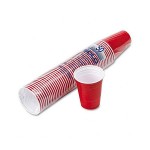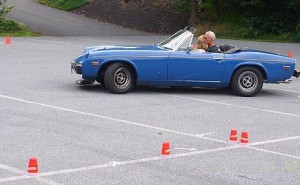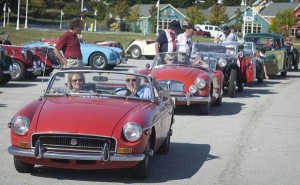Setting Up the Course
General guidelines:
- Allow for an efficient flow of cars and spectators.
- Keep spectators a safe distance from the actual course.
- Recruit enough volunteers and delegate responsibilities.
Traffic Cones. It’s easy to set up a basic funkhana. You have to delineate a route for the cars to follow. Traffic cones work well because they are soft and minimize vehicle damage if run into or over. But with the low speeds of a funkhana, you could use sports cones, those short plastic cones used for marking boundaries of athletic fields. They are available from sporting goods retailers and online by searching for “sports cones.”

For an inexpensive course marker, you could use 16-ounce red plastic cold beverage cups filled with gravel or water to hold them in place. The photo above shows inverted plastic cups at the 2009 Jensen East Nationals.
Don’t wait in line. If your event will have dozens of entrants, it’s important to keep things flowing. That doesn’t mean having 10 cars waiting in line like the drive-thru at Wendy’s. Assign a volunteer to direct arriving cars in a designated parking area near the starting line, then have them walk over to the sign-in or spectator area. Designate an area as the “on deck circle” like in baseball and have the helper keep one or two teams ready to go. By avoiding having the cars lined up one behind the other and creeping forward, the team members won’t be isolated from the rest of the crowd. Plus they can use this time observing other competitors and planning a strategy. Think baseball, not restaurant drive-thru.
Keep it challenging for both team members. When the activity is performed with both people in the car, usually the passenger will responsible for completing a task or scoring points. In this situation, you need to challenge or handicap the driver by creating obstacles in the route, requiring the driver to negotiate the course in reverse, or even driving blindfolded. Be sure to incorporate enough turns and changes in direction to keep speeds low.
Silly sells. Don’t forget that laughter is essential for a successful FUNkhana. Otherwise it becomes an assessment of dexterity, like the compulsory figures once required in figure skating competitions. Boring! Some of the most popular funkhana activities are fashioned after the birthday party games you played as a child. Don’t complicate your funkhana.
Scoring objective. Winner can be determined by points accumulated, elapsed time, or combination of the two. A task like tossing washers into an oil pan can be scored several ways: 1) Number of washers thrown into an oil pan one at a time for a given period, such as 20 seconds; or 2) Starting with a bag containing 10 washers, one point would be awarded for each washer that reaches the target.
Bonus / Penalty / Tiebreaker. Include some secondary scoring variables for added interest. If the goal of a ring toss game is to see how many fan belts you can ring around traffic cones while driving a designated course, then use elapsed time as a tiebreaker. Bonus points could be earned for an accomplishment, such as the driver completing the route without using brakes. Conversely, there could be penalty points each time the brake lights come on.
Help me, Rhonda! Arrange for helpers ahead of time: scorekeepers, judges/referees, setup helpers, traffic cop, janitor. If you’re really organized and your funkhana is a big deal, think about having them all wear shirts of a similar color.










